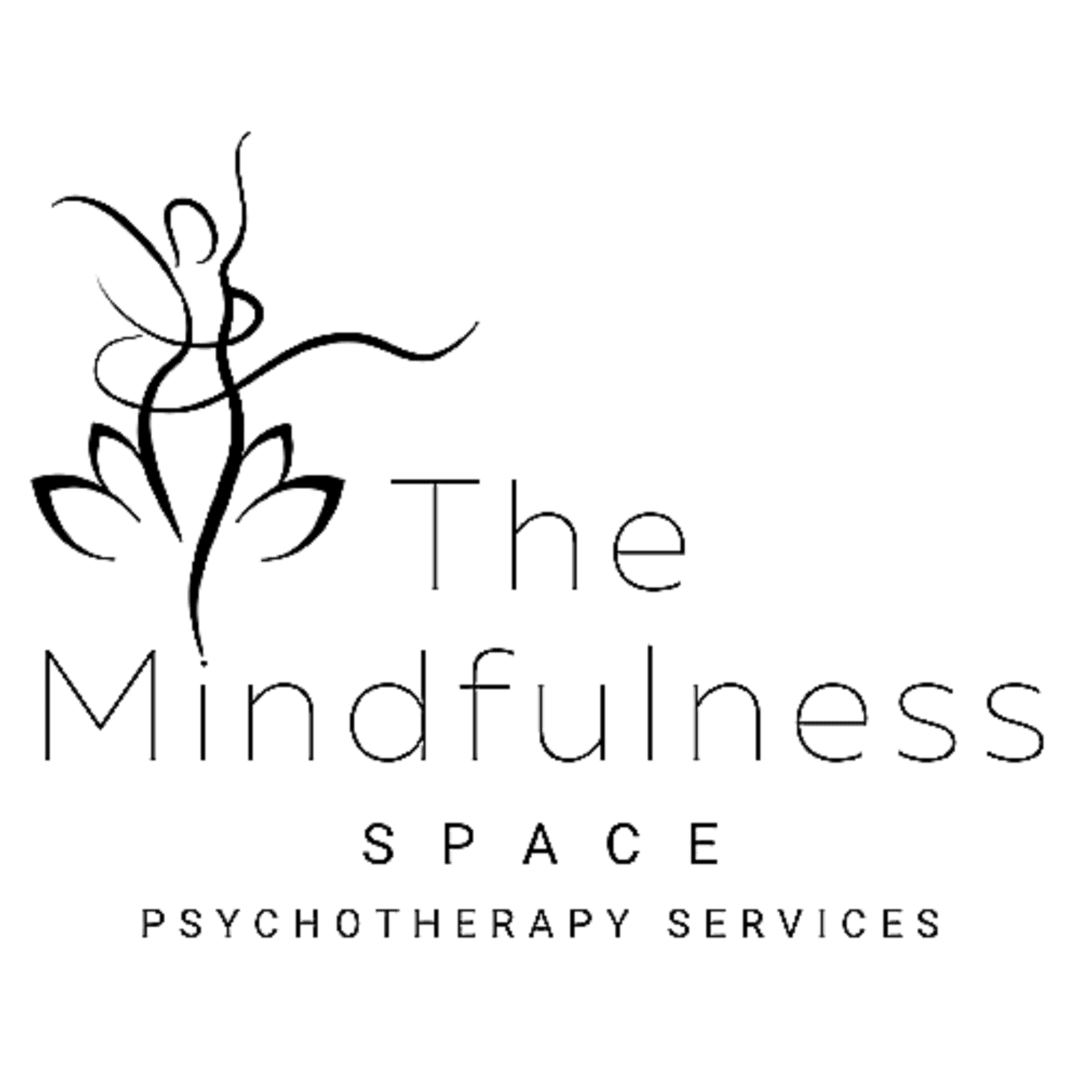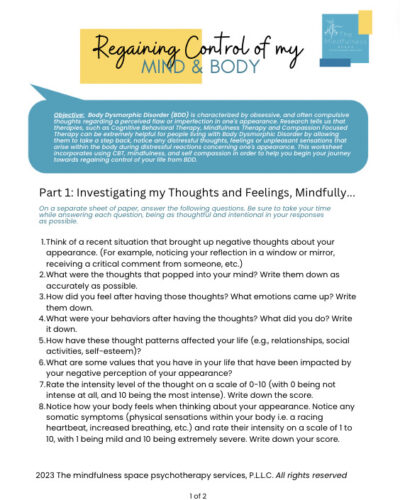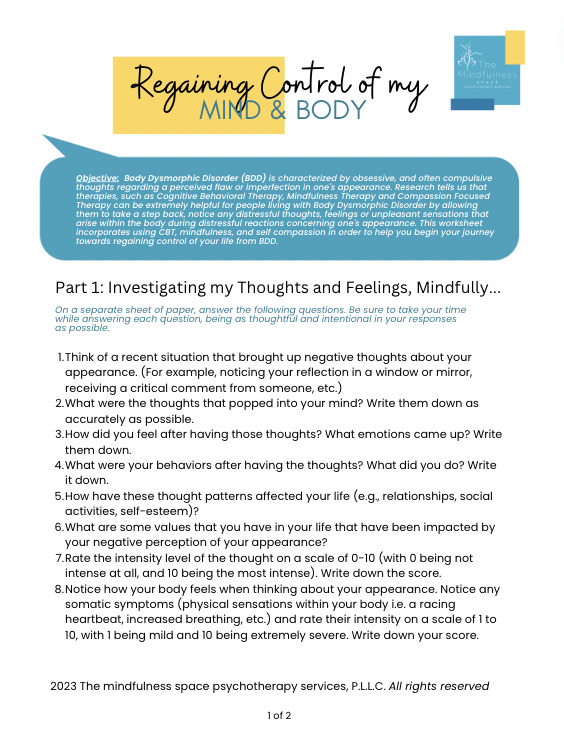What is Body Dysmorphic Disorder? It's Surprisingly more Common than We Think...
What is Body Dysmorphic Disorder?

April 9, 2023
Stefanie M. Lawson, MSW LCSW
The Mindfulness Space Psychotherapy Services, PLLC
“I hate how I look!”
We’ve all experienced those moments. Those days when we spend a little bit more time in front of the mirror than usual, closely examining parts of our body and wondering how that outfit would fit if our waistline was just a little bit smaller. We wonder what that photo would look like if our face were just a little more perfectly proportioned. However, for people who live with Body Dysmorphic Disorder, occasional unpleasant thoughts about one’s body can become a daily compulsive, intrusive and agonizing ordeal.
So What is Body Dysmorphic Disorder?
Body Dysmorphic Disorder (BDD) is a mental health disorder included in the Diagnostic and Statistical Manual of Mental Disorders or DSM and is categorized under the Obsessive and Compulsive-related disorders. BDD is characterized by an excessive and often compulsive preoccupation with a perceived flaw or imperfection in one’s physical appearance that is usually very insignificant or not visible at all to others. This preoccupation with physical appearance is extremely difficult to control or manage and causes individuals diagnosed with BDD to experience significant distress which impairs their daily functioning.
According the the DSM5-TR, BDD affects approximately 2.4% of adults in the United States and was found to be prevalent amongst 2.5% of adult females and 2.2% of adult males. The average age of onset is 16-17 years.
What are the Causes of Body Dysmorphic Disorder?
While the exact causes of BDD are unknown, research suggests that a combination of genetic, environmental, and psychological factors can contribute to the development of this condition.
According to the DSM5-TR, environmental factors that contribute to the development of body dysmorphic disorder can include a history of experiencing childhood neglect, abuse, and trauma, as well as teasing and bullying from peers. Studies have also found that individuals with a family history of BDD or other mental health disorders such as anxiety or depression are more likely to develop BDD (Phillips et al., 2017).
Societal pressures to conform to unrealistic beauty standards, which many specialists and researchers agree are perpetuated by traditional and social media, can also influence the development of BDD. Additionally, psychological factors such as low self-esteem, perfectionism, and cognitive distortions such as selective attention, overgeneralization, magnification and minimization of flaws can exacerbate the symptoms of BDD.
Several research studies examining the neuro-biological factors of BDD suggest abnormalities in visual processing and frontostriatal systems that skew how people living with BDD perceive or interpret visual input (Yaryura-Tobias, et al., 2002). A 2010 study examined the MRIs of seventeen right-handed, medication-free subjects with BDD and 16 matched healthy control subjects.
The subjects were shown “neutral-expression” photographs of their own face and a familiar face or the control stimuli. The photos included ones that were unaltered, as well as ones that were altered to include only high spatial frequency (high resolution) and low spatial frequency (low resolution).

Muscle Dysmorphia is a type of BDD where an individual becomes preoccupied with the idea that his or her body is built too small or insufficiently muscular.”
During the study, participants with BDD were observed to have hyperactivity in the left orbitofrontal cortex (the part of the brain that is thought to impact our decision making, receive sensory input and control our visceral or gut reactions, etc.) and the caudate nucleus of the brain (responsible for directing our emotions) while viewing the unaltered, neutral expression photographs of the subject’s own face vs photographs of “familiar” unaltered control faces (Feusner, et al., 2010).
Enhanced visual detail perception may be responsible for the tendency to be more aware of smaller details that is often present in BDD. Similarly, the increased activity in the brain’s caudate nucleus may be connected to having a stronger than average emotional response to adverse stimuli, like an unflattering selfie or photo.
Symptoms of Body Dysmorphic Disorder
The symptoms of BDD vary in severity and can range from mild to debilitating. The most common symptom of BDD is an excessive preoccupation with a perceived physical flaw or imperfection that others do not see or consider minor. These perceived defects often lead to significant distress and anxiety for the individual, which can result in avoidance of social situations, work, school, or leisure activities. Individuals with BDD often engage in compulsive and repetitive behaviors such as mirror checking, excessive grooming, and seeking reassurance from others regarding their appearance.
These behaviors provide temporary relief from the distress associated with their perceived defect and may be time-consuming and interfere with their daily functioning. Additionally, individuals with BDD may experience depressive symptoms, anxiety, and suicidal ideation (Phillips et al., 2017).
Diagnosing Body Dysmorphic Disorder
Diagnosing BDD can be challenging, as individuals with this disorder often conceal their symptoms due to feelings of shame or embarrassment. In fact, most people living with BDD never seek out mental health treatment and many clinicians fail to properly assess for this disorder.
People living with BDD will often seek treatment for related depressive symptoms, such as feelings of low self-worth and hopelessness surrounding thoughts about their body. They are also more likely to seek treatment for obsessive and compulsive thoughts related to their bodies. In many circumstances, medical practitioners who provide cosmetic surgical procedures are often the first to notice potentially concerning patterns and behavior that may be problematic.
A proper diagnosis is necessary to receive appropriate treatment. The diagnostic criteria for BDD according to the DSM 5-
Diagnosing BDD can be challenging as individuals with this disorder often conceal their symptoms due to feelings of shame or embarrassment.”
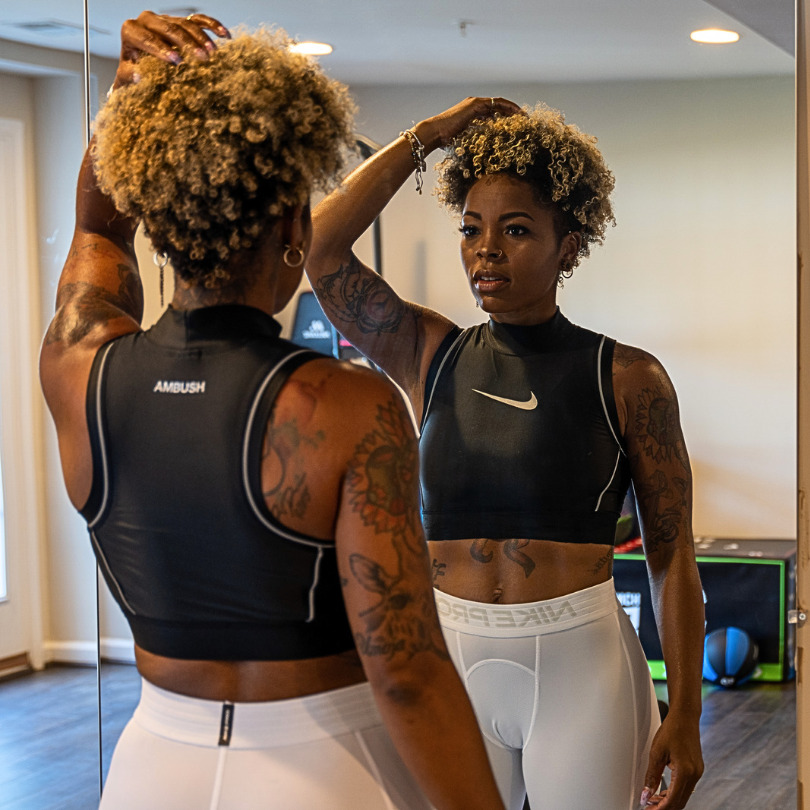
TR include preoccupation with one or more perceived defects or flaws in physical appearance that are not observable or appear slight to others. A history of repetitive behaviors, i.e. mirror checking, excessive grooming, skin picking, and reassurance seeking, or mental acts, such as comparing his or her appearance with that of others in response to the appearance concerns.
The preoccupation with appearance causes clinically significant distress or impairment in social, occupational or other areas of functioning and is not better explained by concerns related to size and weight that are usually present in an eating disorder.
Muscle Dysmorphia is a type of BDD where an individual becomes preoccupied with the idea that his or her body is built too small or insufficiently muscular (American Psychiatric Association, 2022)
A thorough evaluation by a licensed mental health practitioner is necessary to confirm the diagnosis.
Treatment of Body Dysmorphic Disorder
BDD is a treatable condition, and several evidence-based therapies have been shown to be effective in reducing the severity of symptoms and improving the quality of life of individuals with BDD. The most effective treatments for BDD include cognitive-behavioral therapy (CBT), medication, and/or a combination of these approaches. CBT is a short-term therapy that focuses on identifying and challenging negative thoughts and beliefs about one’s appearance and challenging them by identifying more realistic or rational ones. CBT also includes exposure therapy, where individuals gradually face their fears related to their perceived physical flaws in a safe and controlled environment.
Medications such as serotonin reuptake inhibitors (SSRIs) can reduce anxiety and depressive symptoms associated with BDD but are typically used in conjunction with CBT. Additionally, support groups, self-help resources such as books or online forums, and family or couples’ therapy may be helpful in treating BDD (Phillips et al., 2017).
Conclusion
BDD is a complex and distressing mental health disorder that can significantly impact an individual’s quality of life. The causes of BDD are multifactorial. Genetic, environmental, and psychological factors can contribute to its development. The symptoms of BDD include preoccupation with a perceived flaw or defect in one’s physical appearance, avoidance behaviors and depressive symptoms.
Diagnosing BDD requires a thorough evaluation by a mental health professional, and treatment options may include CBT, medication, or a combination of both. Additionally, support groups and self-help resources may be advantageous for individuals with BDD. Early diagnosis and intervention significantly improve the prognosis for individuals with BDD, and seeking professional help is essential in managing this condition.
Do you or does someone you know live with obsessive thoughts and feelings about your body that have become intrusive, emotionally exhausting and are taking over your life? Have you considered or even went through with expensive and often risky cosmetic surgical procedures only to find out that somehow it wasn’t enough to finally make peace with your body?
The Mindfulness Space, located in Greensboro North Carolina offers therapy for Body Dysmorphic Disorder, as well as, accompanying depression, anxiety, obsessive and compulsive, and trauma related symptoms that often show up with BDD.
The Mindfulness Space will help you to begin taking the steps to needed to make peace with your body and regain control over your life!
Contact The Mindfulness Space today for a free 30 minute supportive consultation call and find out how we can help you!
About the Author:
Stefanie is a Licensed Clinical Social Worker in Greensboro North Carolina, with over 7 years of clinical experience and the owner of The Mindfulness Space Psychotherapy Services, an outpatient, size inclusive, HAES aligned, private therapy practice that focuses on helping clients to recover from disordered eating and body image dissatisfaction, as well as, regain control over their relationships with food, body and inner-self!
References:
American Psychiatric Association. (2022). Diagnostic and Statistical Manual of Mental Disorders (5th ed.).
Feusner, J. D., Moody, T., Hembacher, E., Townsend, J., McKinley, M., Moller, H., Bookheimer, S. (2010). Abnormalities of visual processing and frontostriatal systems in body dysmorphic disorder. Archives of General Psychiatry, 67(2), 197-205. https://doi.org/10.1001/archgenpsychiatry.2009.188
Hartmann, A. S., Buhlmann, U., & Phillips, K. A. (2017). Prevalence and underrecognition of body dysmorphic disorder. Body dysmorphic disorder: Advances in research and clinical practice, 49-60.
Yaryura-Tobias, J. A., Neziroglu, F., Chang, R., Lee, S., Pinto, A., & Donohue, L. (2002). Computerized perceptual analysis of patients with body dysmorphic disorder: a pilot study. CNS Spectrums, 7(6), 444446. https://doi.org/10.1017/s1092852900017958
Your Next Step...
Take your next step with The Mindfulness Space!
Schedule your free 30 minute consultation today!
Sign up for our Newsletter!
Are you a provider? Join the email list to sign up for our newsletter today! By signing up, you agree to join The Mindfulness Space’s email list and receive periodic communication with us via newsletter. (See website privacy and terms of use here.) Don’t worry, we won’t spam your inbox! Sign up today! Sign up here!
